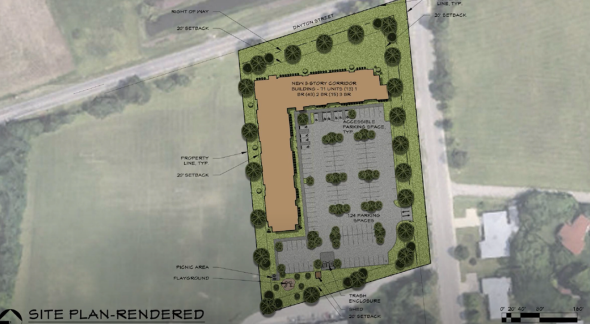
A representative from Columbus-based affordable housing developer Woda Cooper presented the above site plan to the public at a community meeting Thursday, Feb. 6. Had OFA awarded the federal tax credits, Woda Cooper would build a 60-unit apartment — tentatively dubbed "Enon Greene" apartments — on 3.6 acres at the corner of Dayton-Yellow Springs and East Enon roads. (Map data courtesy of Woda Cooper Companies, LLC)
Low-income housing project not selected for funding
- Published: June 2, 2025
After dozens of public meetings; innumerable hours of discussion and debate among elected officials and villagers; and myriad News articles and letters to the editor, a fraught chapter in local housing development history has come to an end.
Last week, the Ohio Housing Finance Agency announced that a proposed low-income housing project in Yellow Springs was not selected for federal funding.
OHFA’s announcement means that plans to build a 60-unit apartment complex — one that would have provided rentals for individuals who fall between 30% and 80% of the area median income — are now stalled indefinitely.
The 3.6-acre Morgan soccer fields, on which the proposed development was slated to be built, will remain recreational, school-district-owned land — at least, for now.
As the News has reported in the past, the request for low-income housing tax credits, or LIHTC, was submitted to OHFA by Columbus-based affordable housing developer Woda Cooper Companies.
Established in 1986, the LIHTC program is an indirect federal incentive used to finance the construction and rehabilitation of affordable rental housing; although governed by the Internal Revenue Service, the LIHTC program is administered through state housing credit agencies such as OHFA.
In this year’s round, 23 proposed low-income housing projects throughout the state were awarded over $35 million in credits; once built, those projects will provide 1,436 new rental units for Ohioans, with around a third of them reserved for individuals 55 and older.
Woda Cooper’s Enon Greene project narrowly missed OHFA’s award threshold.
According to OHFA documents, Woda Cooper’s application competed within OHFA’s “New Affordability General Occupancy” category. Enon Greene garnered a score of 53 — or 93 percent out of 100 — whereas funded projects scored between 54 and 57, the latter of which is a 100 percent score in OHFA’s metric.
However, one funded project — a 54-unit complex in Fayette County, Ohio — scored 42, or nine points below Enon Greene, owing to the developer’s proposed transformative economic development set-aside.
A memo provided to the News from Village Manager Johnnie Burns explained that the Enon Greene project, though competitive in OHFA’s scoring matrices, may have fallen short of successfully awarded projects like the one in Fayette County because of additional funding sources beyond the federal subsidies.
“Although Enon Greene had a lower total development cost [totaling $17.43 million] and included more units [60], it did not have access to the same level of supplemental financing,” the memo reads.
What’s next?
Also in Burns’ memo were several paths forward proposed by Woda Cooper — all of which illustrate a sustained interest from the developer to pursue future applications for LIHTC on the Village’s behalf.
Below are some of Woda Cooper’s proposed next steps:
1. Penning another 9% LIHTC submission in the 2026 round. OHFA is scheduled to release the next statewide “opportunity index” — a mapping framework devised by OHFA and the Kirwan Institute for the Study of Race and Ethnicity at The Ohio State University that analyzes the feasibility of site-specific housing proposals, as well as updated qualified allocation plans — sometime this July. LIHTC-based proposal applications will be due in February of next year, though these applications will be reviewed under updated criteria.
2. The pursuit of low-income housing tax credits in the state’s 4% program. According to the U.S. Department of Housing and Urban Development, the difference between the 4% program and the 9% program — the latter in which Woda Cooper participated this year for the Enon Greene proposal — is based on the amount a LIHTC project is federally subsidized.
A successful 4% LIHTC project proposal receives funds covering 30% of total development costs; a 9% LIHTC project is subsidized by approximately 70% of development costs. Typically, 4% LIHTC proposals are more challenging to realize than 9% proposals.
As Burns’ memo notes, sites in Yellow Springs presently “do not score competitively under the draft guidelines for this program” … though, OHFA’s soon-to-be-updated guidelines “may change in a way that improves [the Village’s] position for a future application.”
3. The pursuit of 4% credits with bond gap financing. Per Burns’ memo: “This program is currently limited to preservation projects and does not allow for new construction. Future updates to the program could broaden eligibility, though that remains uncertain.”
“These options,” the memo states, “depend on the future changes to program guidelines, scoring criteria or funding priorities. Woda Cooper has expressed interest in continuing to explore opportunities in Yellow Springs as those developments occur.”
Project stakeholders respond
Over the last two years, the News has covered the local pursuit of low-income housing tax credits from a number of different angles, invoking the voices of many village residents in favor of and opposed to the LIHTC project.
News reporters spoke with Village staffers, Village Council members, YS school board members, school district leaders, soccer coaches whose teams use Morgan Fields, members of the housing advocacy group Springers for More Springers, members of the local affordable housing nonprofit Home, Inc., Woda Cooper staffers and a number of other area stakeholders.
Following last week’s release of OHFA’s LIHTC awards, the News again checked in with some of these groups.
“Even though this LIHTC application didn’t succeed, I don’t feel the work was at all wasted,” YS Board of Education President Rebecca Potter said.
“I appreciate the Village’s support on disencumbering the land [owned by the school district],” she said, referring to last year’s efforts to work around a collateral lien on the Morgan Fields, as well as the municipal push to rezone the 3.6 acres to accommodate high-density housing.
“I’m personally hoping the scoring is more favorable next time,” Potter added. “We need to be very active about getting more families into the district. As a school board member, that was my number one reason for pushing this — more affordable housing in Yellow Springs means more students in our schools.”
Potter’s colleague, board member Amy Bailey, told the News that she is grateful the Morgan soccer fields will remain as they are. Bailey said she supports future efforts to bring more housing to Yellow Springs, but next time, not at the expense of school resources and with better villagewide communication.
“When we got to the end of this process, there were still so many questions — what would have been the impact on the district, how many units would be built, what would the impact on traffic be,” Bailey said.
Somewhat in contrast to her fellow board member’s remarks, Bailey said future efforts to provide housing for would-be Yellow Springs Schools students and their families shouldn’t be the concern of the district, but rather of the Village.
Village Council member Brian Housh, who like Potter was stalwart in pushing the LIHTC project through municipal channels, lamented the failure of this year’s submission. Still, he remains optimistic for the future.
“We invested a lot of work and time in just getting up to speed,” Housh said. “We made a genuine effort to put in our best submission. The biggest takeaway should be that now we know to be more prepared and as nimble as possible for when the next opportunity arises.”
YS Home, Inc. Executive Director Emily Seibel echoed Housh’s sentiments.
“We’re saddened to learn this project wasn’t funded, even though it was very close to being competitive,” Seibel said. “But we’re still ready to roll up our sleeves and collaborate on whatever comes next.”
Though Woda Cooper was ultimately selected as the lead developer on this LIHTC project, Seibel and other Home, Inc. representatives were the first to bring the LIHTC opportunity before Village Council in fall 2023 and hoped to be partners if the project was funded.
“Now that we know Woda [Cooper] is willing to issue financial guarantees — the major roadblock to Home, Inc. being certified as a community housing development organization, or CHDO — we hope to be involved early on as the local CHDO on any future LIHTC application,” Seibel said.
Seibel added that this latest effort was the fourth LIHTC project application Home, Inc. has been involved with over the last 15 years.
“It’s highly competitive and these funds are difficult to secure,” she said.
Seibel said she’s optimistic for the Village’s next steps and any forthcoming efforts to pursue future LIHTC monies.
“The stakes are too high for our village not to keep at it until we’re successful in bringing more affordable family rentals to Yellow Springs,” she said. “[Home, Inc.] has more than 350 households on our rental interest list. We get calls every week. For us to be a strong town with a strong social fabric, it requires economic diversity — it requires these kinds of housing projects to succeed.”
Seibel added: “We’re not going to give up.”
Representatives from Woda Cooper did not offer any comment, following multiple attempts from the News. Two of the development company’s other LIHTC proposals — both of which are in Columbus — were awarded the federal funding they sought.
The Yellow Springs News encourages respectful discussion of this article.
You must login to post a comment.
Don't have a login? Register for a free YSNews.com account.













No comments yet for this article.